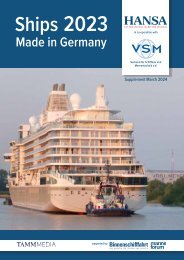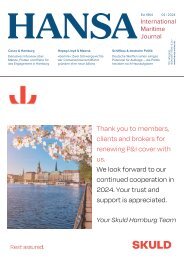HANSA 01-2021
Hull Performance & Coating · Svitzer · Yacht »Soaring« · Schifffahrtsaktien & Börsen · Harren & Partner · LNG in der Schulte-Gruppe · Berenberg Bank · Schiffsinspektionen
Hull Performance & Coating · Svitzer · Yacht »Soaring« · Schifffahrtsaktien & Börsen · Harren & Partner · LNG in der Schulte-Gruppe · Berenberg Bank · Schiffsinspektionen
Sie wollen auch ein ePaper? Erhöhen Sie die Reichweite Ihrer Titel.
YUMPU macht aus Druck-PDFs automatisch weboptimierte ePaper, die Google liebt.
SCHiFFFaHrt | SHiPPiNG<br />
Digital Maritime Training in Covid-19 Times<br />
Covid-19 has changed everything in our private and our business world. teaching<br />
environments and techniques have also evolved in response<br />
Like it or not, we have all had to embrace<br />
digital, remote forms of training<br />
- rapidly. The first response was to<br />
employ ad-hoc measures such as delivering<br />
traditional classroom lectures as<br />
videoconferences. But at the same time,<br />
a more fundamental discussion has started<br />
on how to provide quality training if<br />
the pandemic stays with us for longer.<br />
Two key forms<br />
looking at required cost and time, it became<br />
quickly apparent that for us the focus<br />
should be on two key training forms:<br />
live online training (aka virtual classroom)<br />
and self-paced learning using recently<br />
evolved development software which has<br />
brought down development times and<br />
costs significantly, while at the same time<br />
improving trainee satisfaction with the<br />
»look and feel« of the training products.<br />
Most training courses employ a blend<br />
of these options. E.g. self-paced online<br />
training is ideal for resource libraries<br />
with reading material, multiple-choice<br />
tests, and background knowledge. live<br />
online training (using for example, Microsoft<br />
teams or Zoom) for kick-off and<br />
closure of training, Q&a sessions, and<br />
short group activities in purpose-made<br />
virtual break-out rooms. Experience with<br />
customers shows that such a mixture is<br />
very well received.<br />
Comparing traditional training with<br />
digital options, we have a digital equivalent<br />
for almost all modes of training:<br />
reading, frontal lectures, exercises, discussions<br />
and assessment. if a traditional<br />
training is well designed using visually<br />
stimulating material with interspersed<br />
activities for the trainees, the conversion<br />
to digital equivalents is straightforward.<br />
only the coffee breaks with real coffee<br />
and initial social bonding are vastly better<br />
in the real world…<br />
Key risk<br />
a key risk with self-paced learning is<br />
that the trainee does not study, whether<br />
it is with an old-fashioned textbook or an<br />
e-learning course. Purely self-paced online<br />
courses generally have less impact<br />
than classroom training where individual<br />
feedback is possible and where learners<br />
generally have a higher attention rate.<br />
longer courses are generally subdivided<br />
into modules of typically 20-60 minutes’<br />
duration.<br />
due to their longer duration, web<br />
courses generally employ a wider range<br />
of techniques to avoid fatigue. The training<br />
material employs techniques akin to<br />
PowerPoint presentations – text (sometimes<br />
animated), images, embedded videos.<br />
in principle, all the good advice for<br />
designing PowerPoint presentations for<br />
classroom training also applies to designing<br />
e-learning modules. in addition,<br />
some web authoring tools allows information<br />
on demand (e.g. mouse-over popup<br />
explanations, magnifying of images,<br />
links to websites or pdf documents). information<br />
on demand allows decluttering<br />
slides with faster progress for those who<br />
don’t need the extra details.<br />
»I know…«<br />
While not glamorous, downloadable<br />
pdf files and online reading text are often<br />
a good and cost-effective option<br />
in training. Sometimes it makes more<br />
sense to deliver new training content in<br />
the form of a job aid. don’t stretch out a<br />
small amount of content in order to create<br />
an hour e-learning course. transferring<br />
classroom training to digital solutions,<br />
we often include links to pdf files or<br />
websites, where the reference knowledge<br />
can be found, and focus on the learning<br />
goals: »i know this resource exists«, »i<br />
know where to find it« and »i know how<br />
to work with it«.<br />
live online training keeps the trainer<br />
in the loop, with all its pros and cons. a<br />
charismatic trainer can capture any audience,<br />
just as a trainer without charisma<br />
may lose the audience even in a real<br />
classroom. Even in the best conditions,<br />
online training will be more fatigu-<br />
28 HaNSa – international Maritime Journal <strong>01</strong> | <strong>2021</strong>


















